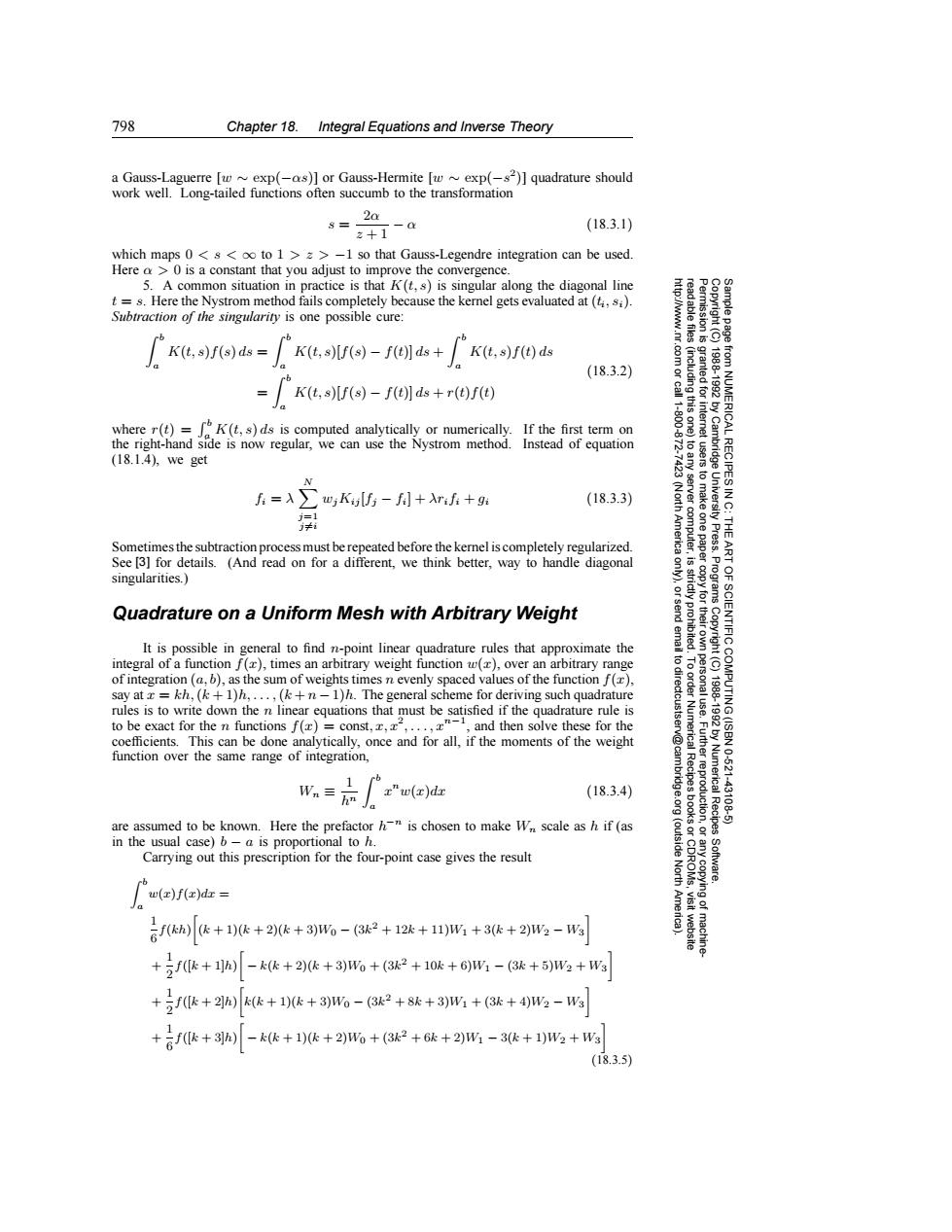正在加载图片...

798 Chapter 18.Integral Equations and Inverse Theory a Gauss-Laguerre [w~exp(-as)]or Gauss-Hermite [w~exp(-s2)]quadrature should work well.Long-tailed functions often succumb to the transformation 2+1-a (18.3.1) which maps 0<s<oo to 1>>-1 so that Gauss-Legendre integration can be used. Here o>0 is a constant that you adjust to improve the convergence 5.A common situation in practice is that K(t,s)is singular along the diagonal line t=s.Here the Nystrom method fails completely because the kernel gets evaluated at(,s). Subtraction of the singularity is one possible cure: K(t,s)f(s)ds= K(t,s)[f(s)-f(t)]ds+ K(t,s)f(t)ds (18.3.2) K(t,s)[f(s)-f(t)]ds+r(t)f(t) 是2%a nted for where r(t)=K(t,s)ds is computed analytically or numerically.If the first term on the right-hand side is now regular,we can use the Nystrom method.Instead of equation (18.1.4),ve get wj Kislfs -fi]+Arifi+gi (18.3.3) (Nort server 2 America University Press. THE Sometimes the subtraction process must be repeated before the kernel is completely regularized. See [3]for details.(And read on for a different,we think better,way to handle diagonal ART singularities. 9 Programs Quadrature on a Uniform Mesh with Arbitrary Weight It is possible in general to find n-point linear quadrature rules that approximate the 是 integral of a function f(),times an arbitrary weight function ()over an arbitrary range 可 of integration (a,b),as the sum of weights times n evenly spaced values of the function f(), say at kh,(+1)h,...,(k+n-1)h.The general scheme for deriving such quadrature rules is to write down then linear equations that must be satisfied if the quadrature rule is to be exact for the n functions f()=const,x,,...,x" and then solve these for the OF SCIENTIFIC COMPUTING(ISBN 0-521- coefficients.This can be done analytically,once and for all,if the moments of the weight function over the same range of integration, 1 (18.3.4) 1988-1992 by Numerical Recipes -43198.5 are assumed to be known.Here the prefactor h"is chosen to make Wn scale as h if(as in the usual case)b-a is proportional to h. (outside Carrying out this prescription for the four-point case gives the result Software. 。w(ofei= Amer 若hk++20k+3wo-32+12k+1)w+3k+2w-Wm +fk+1h)-kk+2k+3)Wo+(3k2+10k+6)W1-(3+5)W2+W +2fk+2h)k+1k+3)W%-3k2+8k+3)w+(3k+4W-W +a0k+3[-kk+1k+2w%+(3k2+6k+2)W-3+1w+W (18.3.5)798 Chapter 18. Integral Equations and Inverse Theory Permission is granted for internet users to make one paper copy for their own personal use. Further reproduction, or any copyin Copyright (C) 1988-1992 by Cambridge University Press. Programs Copyright (C) 1988-1992 by Numerical Recipes Software. Sample page from NUMERICAL RECIPES IN C: THE ART OF SCIENTIFIC COMPUTING (ISBN 0-521-43108-5) g of machinereadable files (including this one) to any server computer, is strictly prohibited. To order Numerical Recipes books or CDROMs, visit website http://www.nr.com or call 1-800-872-7423 (North America only), or send email to directcustserv@cambridge.org (outside North America). a Gauss-Laguerre [w ∼ exp(−αs)] or Gauss-Hermite [w ∼ exp(−s2)] quadrature should work well. Long-tailed functions often succumb to the transformation s = 2α z + 1 − α (18.3.1) which maps 0 <s< ∞ to 1 >z> −1 so that Gauss-Legendre integration can be used. Here α > 0 is a constant that you adjust to improve the convergence. 5. A common situation in practice is that K(t, s) is singular along the diagonal line t = s. Here the Nystrom method fails completely because the kernel gets evaluated at (ti, si). Subtraction of the singularity is one possible cure: b a K(t, s)f(s) ds = b a K(t, s)[f(s) − f(t)] ds + b a K(t, s)f(t) ds = b a K(t, s)[f(s) − f(t)] ds + r(t)f(t) (18.3.2) where r(t) = b a K(t, s) ds is computed analytically or numerically. If the first term on the right-hand side is now regular, we can use the Nystrom method. Instead of equation (18.1.4), we get fi = λ N j=1 j=i wjKij [fj − fi] + λrifi + gi (18.3.3) Sometimes the subtraction process must be repeated before the kernel is completely regularized. See [3] for details. (And read on for a different, we think better, way to handle diagonal singularities.) Quadrature on a Uniform Mesh with Arbitrary Weight It is possible in general to find n-point linear quadrature rules that approximate the integral of a function f(x), times an arbitrary weight function w(x), over an arbitrary range of integration (a, b), as the sum of weights times n evenly spaced values of the function f(x), say at x = kh,(k + 1)h, . . . ,(k + n − 1)h. The general scheme for deriving such quadrature rules is to write down the n linear equations that must be satisfied if the quadrature rule is to be exact for the n functions f(x) = const, x, x2,...,xn−1, and then solve these for the coefficients. This can be done analytically, once and for all, if the moments of the weight function over the same range of integration, Wn ≡ 1 hn b a xnw(x)dx (18.3.4) are assumed to be known. Here the prefactor h−n is chosen to make Wn scale as h if (as in the usual case) b − a is proportional to h. Carrying out this prescription for the four-point case gives the result b a w(x)f(x)dx = 1 6 f(kh) (k + 1)(k + 2)(k + 3)W0 − (3k2 + 12k + 11)W1 + 3(k + 2)W2 − W3 + 1 2 f([k + 1]h) − k(k + 2)(k + 3)W0 + (3k2 + 10k + 6)W1 − (3k + 5)W2 + W3 + 1 2 f([k + 2]h) k(k + 1)(k + 3)W0 − (3k2 + 8k + 3)W1 + (3k + 4)W2 − W3 + 1 6 f([k + 3]h) − k(k + 1)(k + 2)W0 + (3k2 + 6k + 2)W1 − 3(k + 1)W2 + W3 (18.3.5)���